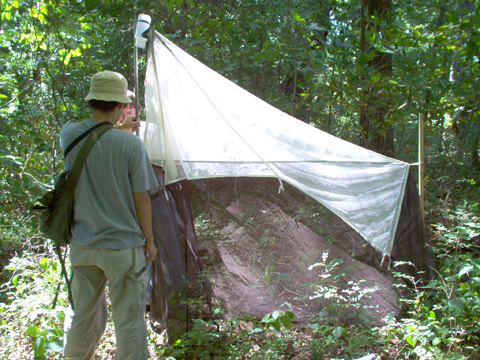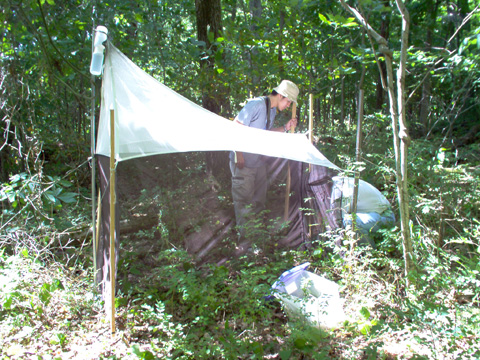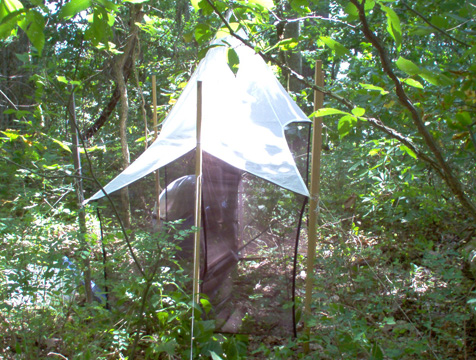Malaise TrapsAuthor: Joe A. MacGown |
Malaise traps are tent-like traps made of fine mesh material and used primarily for the collection of flies (Diptera) and wasps (Hymenoptera), although they also catch a great many other flying insects. Malaise traps are generally set out for long periods of time and checked at least weekly, or occasionally every other week. Basically, a malaise trap has two short end walls, one central wall, and a roof, which is only peaked on one end, or in some styles, both ends. The walls are generally black and the roof is usually white. Poles, wooden or otherwise, are used to support the trap at each corner and at the peak in front. It is helpful if the front pole is adjustable so that the sample jar may be raised and lowered. The poles are in turn tied to stakes placed in the ground several feet away. If necessary, the ropes (or strings) may be tied to something. The traps we use are about 5 ft high at the front peak, 4 ft high in the back, about 6 ft long, and 3 feet wide. They are many variations on this basic design, but you get the picture. Insects hit the middle mesh wall and either fly upward or downward. Those insects that fly upward are funnel to the peak of the trap and eventually find their way into a jar with some sort of killing agent. We have found that alcohol works best for us because it preserves the insects over the course of a week well and also aids in keeping the inevitable lepidopteran scales from sticking to all of the other insects in the sample. Alternatively a dry killing agent such as no-pest strip (vapona) can be used. If using a dry killing agent, one should check the sample more often, even daily. One of the hardest parts of setting a malaise trap up is finding the ideal location and position to maximum the collecting. Typically, they are set up at right angles to an insect flight line. In some cases this is easy, because there is a natural or artificial opening that funnel insects through an area, but in other cases it is very difficult. If a hedge line, or thick forest edge is present, the trap may be placed next to it, especially on the north side of an edge running east to west. It is recommended that the bottle end be placed nearest the edge, but we have had luck either way. When searching for suitable spots, try to envision what the area will look like at different times of day. Many insects seem to gather in sun dappled spots, for example, and a spot that is in a area receiving sun more of the day will probably be better. Also, consider the extent of the undergrowth and how it may change through the course of time the trap will be out. Vegetation may grow so high that it restricts insect flight to and through the trap. For those insects that have a tendency to fall downward when hitting a barrier, pans containing a preservative can be placed below the central portion of the trap. |
 |
Terry and Edda (grad student) putting up a malaise trap. |
 |
Nan (grad student) helping Terry put up a malaise trap. |
 |
Finishing touches. |
 |
Back view of malaise trap. |
 |
A finished malaise trap in on a steep hillside in a glade. |


